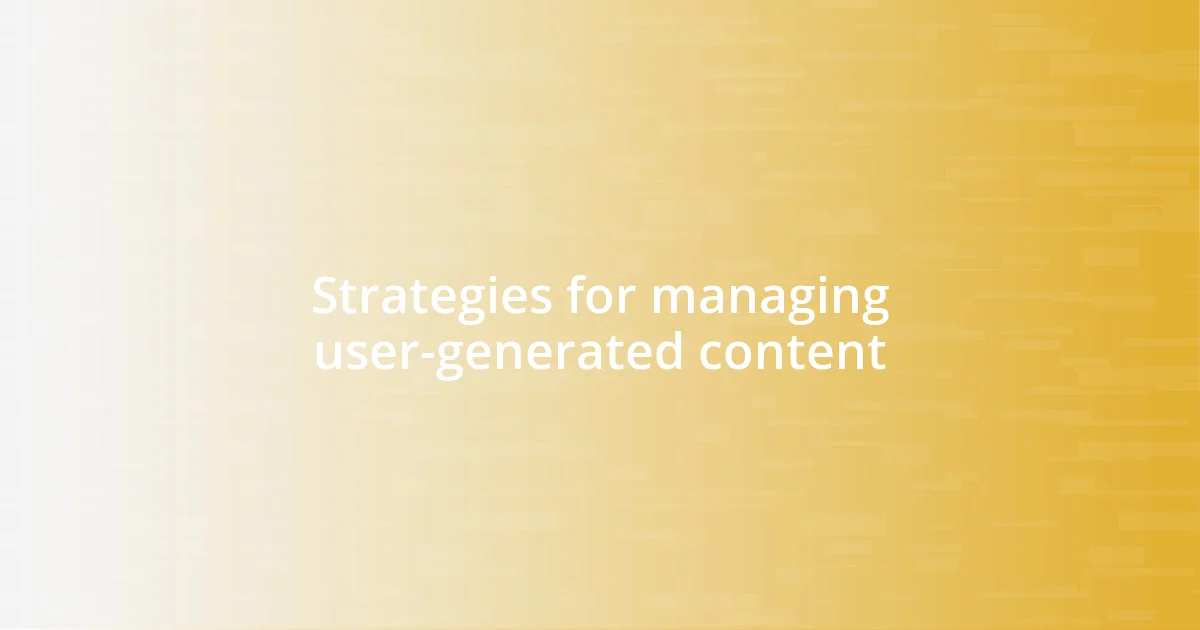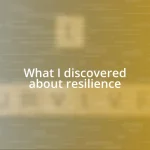Key takeaways:
- User-generated content (UGC) enhances brand authenticity, builds trust, and fosters community engagement, making it an essential marketing tool.
- To encourage UGC, brands should create engaging challenges, recognize contributions, and maintain open communication with their audience.
- Legal considerations for UGC include understanding copyright, liability risks, and platform terms of service to avoid potential legal issues.

Understanding user-generated content
User-generated content (UGC) is more than just a trendy term; it’s a vibrant reflection of consumer creativity and authentic experiences. I remember scrolling through social media and stumbling upon a photo of a meal at a local restaurant. The captivating image not only made my mouth water but also sparked my curiosity. How powerful is it when your peers share something genuine, making you trust a brand more than traditional ads?
By engaging with UGC, brands gain insights that are often overlooked. For instance, I’ve seen how companies react to reviews and images shared online, sometimes making positive changes based on feedback. Isn’t it fascinating how a single post can influence a brand’s direction? This symbiotic relationship cultivates a sense of community, allowing customers to feel valued and heard, something I think many brands should prioritize.
Furthermore, UGC enhances a sense of belonging among users. When I participated in a campaign by sharing my own experience with a product, it felt rewarding to contribute to something bigger. Have you ever felt that rush of seeing your content featured? It’s incredible how UGC not only showcases personal stories but also fosters connections between individuals and brands, leading to deeper customer loyalty.

Benefits of user-generated content
User-generated content (UGC) is incredibly beneficial for brands looking to build trust with their audience. I vividly recall a time when I chose a vacation destination based purely on the stunning images shared by travelers on social media. Those real-life snapshots told a story that no advertisement could replicate, making me feel confident about my choice. This trust leads to higher engagement rates, as consumers are more likely to interact with content that feels genuine and relatable.
- Authenticity: UGC brings a level of authenticity that brands often struggle to achieve through traditional marketing.
- Cost-Effectiveness: By leveraging content created by consumers, brands can save on advertising costs while boosting outreach.
- Community Building: UGC fosters a sense of community among users, making them feel like a part of the brand’s journey.
- Engagement: Content generated by users often sees higher engagement because it resonates with audiences on a personal level.
- Social Proof: Seeing others endorse a product or service creates social proof, encouraging potential customers to make a purchase.
I remember when a clothing brand featured customer photos on their website. It wasn’t just about the clothing; it was like stepping into the lives of those wearing it. This connection made me feel compelled to shop there, as I could envision myself within that community. The emotional pull of UGC is remarkable—it allows brands to connect with their consumers on a human level, which can be a game-changer in today’s crowded marketplace.

How to encourage user-generated content
To encourage user-generated content, it’s essential to create opportunities for your audience to share their unique experiences. For example, running social media challenges can spark creativity and motivate users to post their content. I once took part in a photo challenge where we had to share our best moments using a specific product. The thrill of being part of something larger made me want to participate even more. Have you ever felt inspired to capture a moment just because it might be shared? That’s the kind of excitement brands should tap into!
Another effective way to encourage UGC is to recognize and reward contributions. I recall a time when a brand showcased user photos on their website and offered discounts to those featured. The sense of validation I felt when my pic was highlighted made me a loyal customer for life. This concept of gamification—adding fun and rewards—fuels enthusiasm among users. It invites them to share their stories, creating a win-win environment for both the brand and the customer.
Lastly, maintaining an open line of communication is critical. I’ve seen brands that actively respond to user content thrive because they make their followers feel valued. Engaging with consumers by liking, sharing, or commenting on their posts encourages them to keep creating. I often find myself posting more content when I know a brand truly appreciates my input. Isn’t it fulfilling to be heard and acknowledged? That connection is what will keep the UGC flowing.
| Strategy | Description |
|---|---|
| Engaging Challenges | Create social media challenges to inspire users to share their experiences. |
| Recognition and Rewards | Showcase user contributions and offer incentives, like discounts. |
| Open Communication | Engage with users by responding and interacting with their content. |

Best platforms for user-generated content
When it comes to showcasing user-generated content, platforms like Instagram and TikTok excel. I remember scrolling through TikTok, where users create catchy videos around products, turning ordinary items into stars. Do you ever find yourself laughing at a funny review or inspired by a stellar unboxing? That spontaneity and creativity fuel engagement in ways traditional ads can’t match.
Another standout platform for UGC is YouTube. I once stumbled upon a makeup tutorial where the creator used a brand’s products while sharing honest feedback. This real-world experience resonated with me, making me trust the products even more. YouTube allows for in-depth storytelling, enabling users to showcase their creativity while offering authentic product experiences that can’t be replicated through polished ads.
Finally, Pinterest serves as a treasure trove for user-generated content. I often find myself pinning DIY projects that showcase creative uses for products I love. Have you noticed how much inspiration you can gather from a simple pin? It transforms everyday products into something extraordinary. The sense of community I feel when I see others’ creative takes encourages me to contribute my own ideas, making Pinterest a perfect platform for sharing user-generated magic.

Strategies for managing user-generated content
When managing user-generated content, it’s crucial to establish clear guidelines and expectations for your audience. I remember a time when I hesitated to post content because I wasn’t sure what a brand was looking for. By outlining the type of submissions you want, you create a roadmap for users that not only inspires them but also enables you to curate the best content for your brand’s image. Have you ever felt more confident sharing, knowing exactly what was desired?
Another effective strategy is to actively monitor and moderate the content being shared. In my experience, I’ve seen brands thrive by set rules that ensure all UGC aligns with their values and quality standards. This doesn’t mean stifling creativity but rather guiding it. Engaging in a supportive and respectful way can foster a sense of community while ensuring that the content reflects the brand positively. Isn’t it amazing how a little guidance can lead to a diverse and vibrant collection of contributions?
Lastly, leveraging the power of analytics can significantly enhance UGC management. I learned that keeping track of which types of content resonate most allows brands to refine their approach. By analyzing engagement metrics, such as likes, shares, and comments, you can identify trends and adapt your strategies accordingly. Have you noticed how certain posts just seem to hit home? That’s data in action, guiding content creation for even better results.

Legal considerations for user-generated content
When it comes to user-generated content, one of the primary legal considerations is copyright. I’ve often found myself wondering, “Who really owns the content shared online?” In most cases, the original creator retains copyright over their creations, which means brands must take care when using this content, even if it’s shared publicly. Simply reposting or using someone’s photo without permission could lead to unwanted legal disputes.
Another factor to keep in mind is the issue of liability. I recall a situation where a brand featured a user’s post that unintentionally included negative comments about another product. This sparked a flurry of backlash, making me realize how crucial it is to vet UGC for potential legal pitfalls. If a post misrepresents a brand or promotes false claims, it can open the door for defamation lawsuits or other liabilities. The last thing any brand wants is to find itself on the wrong side of a legal battle over content that someone else created.
Finally, it’s essential to consider the terms of service of the platforms where UGC is shared. I can’t tell you how many times I’ve clicked through a service agreement without really reading the details. Many social media platforms have specific rules regarding content use, and understanding these can help brands navigate the fine print to avoid unintentional violations. So, next time you’re tempted to share an irresistible post from a user, take a moment to think: “Am I fully aware of the rights and restrictions that come into play here?” Keeping these considerations in mind will foster a more ethical and legally sound approach to leveraging user-generated content.















